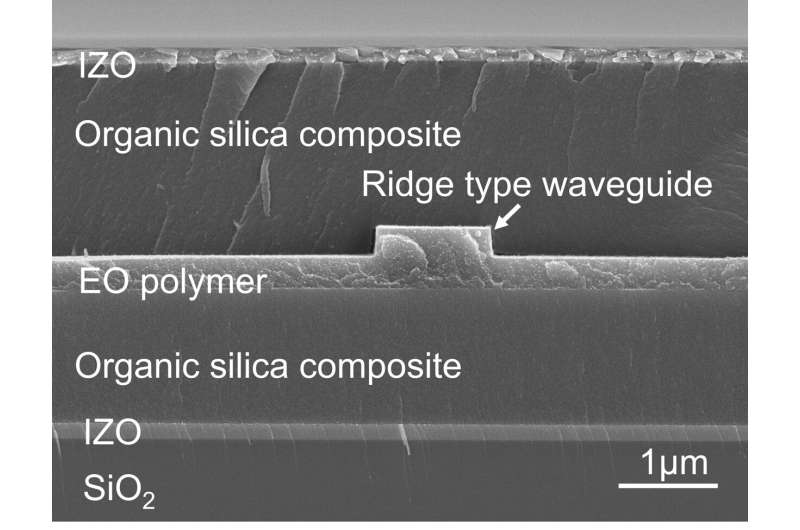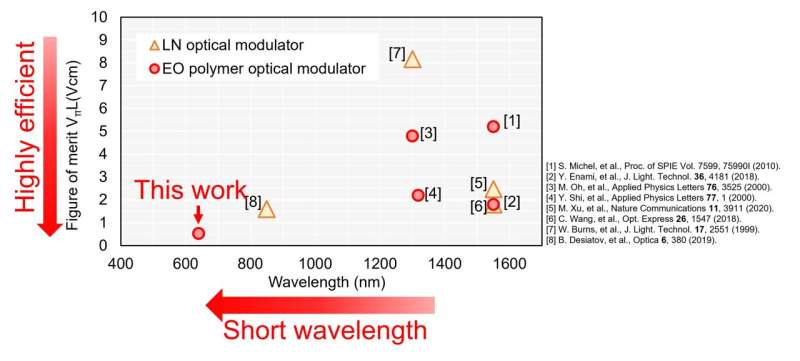Schematic diagram of EO polymer optical modulator for visible light. The input light propagates through the EO polymer waveguide, and an output optical signal corresponding to the electric signal is output. Credit: National Institute of Information and Communications Technology (NICT)
The National Institute of Information and Communications Technology has successfully developed a highly efficient optical modulator using organic electro-optic polymer (hereinafter referred to as EO polymer) for visible light. Conventional EO polymer optical modulators could operate in near-infrared light (wavelength 1,550 nm, etc.), but they couldn't be used for visible light (wavelength 380 nm to 780 nm) because of the large absorption loss. NICT has developed an EO polymer which experiences small absorption loss in visible light and has the large electro-optic coefficient required for the optical modulator. We fabricated an optical modulator using this EO polymer by microfabrication technology and operated the optical modulator in visible light (red, wavelength 640 nm). The demonstrated optical modulator for visible light is smaller and more efficient than the conventional EO polymer optical modulator for near-infrared light.
This EO polymer optical modulator for visible light is expected to be applied to next generation display devices such as stereoscopic displays and smart glasses. The research was published in Optics Express.
The growth of global internet traffic has led to the demand for high-performance optical networks. NICT is developing a high-speed, low-voltage optical modulator using EO polymer. Optical modulators which convert electrical signals to optical signals are key devices for telecommunications. Compared to conventional lithium niobate optical modulators, EO polymer optical modulators can only be used with near-infrared light for optical communications.
In this research, we successfully developed an EO polymer which has low absorption and high electro-optic coefficient in visible light. This result was achieved by NICT's accurate measurement technology and molecular design based on the vast molecular structure library accumulated over many years. By designing the EO molecule structure to be short and rigid to suppress the absorption loss at visible light, this EO polymer has less than 1/20,000 absorption loss than conventional EO polymer and is available for visible light.
Cross section of EO polymer optical modulator for visible light. IZO (Indium Zinc Oxide) electrode are placed at the top and bottom of waveguide. Credit: National Institute of Information and Communications Technology (NICT)
NICT designed and fabricated a Mach-Zehnder interferometer structure using a microfabrication process. The waveguide size for operating at visible light is necessarily smaller than a conventional optical modulator for near-infrared light. We have adopted a ridge type waveguide which guarantees a single mode even if the width of the waveguide is relatively large. As a result, although high accuracy processing is required, the fabrication tolerance is relaxed.
An electric signal was added to the developed optical modulator, and the modulation operation was evaluated. As a result, the figure of merit of optical modulators was 0.52 Vcm at a wavelength 640 nm (red color). This result is less than one-third of the traditional figure of merit which means extreme efficiency (small size and low driving voltage). Furthermore, the operating wavelength is significantly shorter than before.
Relationship between operation wavelength and figure of merit of optical modulator. (This work and previous LN and EO polymer optical modulator.) Credit: National Institute of Information and Communications Technology (NICT)
Future prospects
This research result is a pioneering achievement that can bring about innovations in light beam control and display technology. The optical modulator which can control the phase of propagation light can be used for an optical phased array. The optical phased array for visible light can be available for stereoscopic displays. Compact and highly efficient display devices can be expected to be mounted in next-generation wearable terminals such as smart glasses. Furthermore, a low-cost silicon-based photodetector can be used with visible light, which leads to cost reduction of the entire system.
"I will continue to promote research and development of the optical phased array for next-generation display," said Kamada Shun. We will also aim to develop EO polymers for green and blue, and expand their applications to full color stereoscopic displays.
More information: Shun Kamada et al, Superiorly low half-wave voltage electro-optic polymer modulator for visible photonics, Optics Express (2022). DOI: 10.1364/OE.456271
Journal information: Optics Express
Provided by National Institute of Information and Communications Technology (NICT)


























